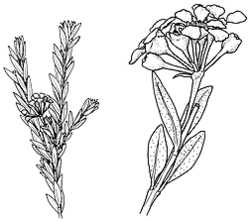Sannantha collina (A.R.Bean) Peter G.Wilson APNI* Synonyms: Babingtonia collina A.R.Bean APNI*
Babingtonia sp. Mt Crosby (Bird AQ635744) APNI*
Baeckea virgata sensu Wilson, Peter G. in Harden, G.J. (1991) Flora of New South Wales 2: 184 p.p. APNI*

Description: Shrub to 3 m high; branchlets 4-angled, not flanged.
Leaves lanceolate, 6.5–12.5 mm long, 1.7–2.5 mm wide, apex acute, margins entire, oil glands prominent, especially on the lower surface; petiole 0.6–1.3 mm long.
Inflorescences usually with 3–11-flowered, mostly 7-flowered; peduncle 5–9.5 mm long; pedicels 2.5–4 mm long, bracteoles triangular, to 1.2 mm long.Hypanthium smooth. Calyx lobes simple, c. 0.6 mm long. Corolla to 8 mm diam.; petals circular, 2–2.8 mm long. Stamens usually 8–11.
Capsule c. 3 mm diam.; seeds flattened, semi-discoid.
Flowering: Flowers mostly November to March.
Distribution and occurrence: Grows in shrubland or eucalypt forest, often in shallow sandy soils, or in riparian communities; chiefly on the ranges north from Dorrigo, also in the Ashford district.
NSW subdivisions: NC, NWS
Other Australian states: Qld
Previously included in Baeckea virgata (J.R. Forst. & G. Forst.) Andrews
Text by Peter G. Wilson
Taxon concept: Wilson et al. (2007) Australian Systematic Botany 20: 302-318.
APNI* Provides a link to the Australian Plant Name Index (hosted by the Australian National Botanic Gardens) for comprehensive bibliographic data
***The AVH map option provides a detailed interactive Australia wide distribution map drawn from collections held by all major Australian herbaria participating in the Australian Virtual Herbarium project.
|


